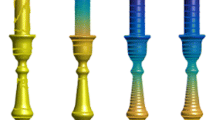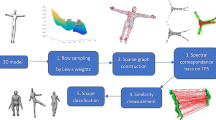Abstract
Sparse data sets are an ever-present problem in many fields of computer science. In the shape retrieval community, several researchers use graph transduction algorithms to reveal the underlying structure of the shape manifold. Without an infinite number of shapes, the data sets can only imprecisely describe the shape manifold. For this problem, adding synthetic data points can be very effective. However existing methods add synthetic points only in feature space. In distance spaces, which are often non-metric and are widely used in bioinformatics, time series classification, shape similarity, and other domains, it is impossible to use these standard, feature-based methods, such as SMOTE, to insert synthetic points. Instead, we present an innovative approach that adds synthetic points directly to distance spaces. We call these synthetic points ghost points since they are not represented by vectors of features, and consequently, cannot be directly visualized. However, we can define the distances of ghost points to all other data points. Our experimental results on standard data sets show that ghost points not only significantly improve the accuracy of shape retrieval, but also the accuracy of image retrieval. We also discuss the conditions that allow the ghost points to improve retrieval results.
















Similar content being viewed by others
Notes
This fact was pointed out to us by an anonymous reviewer of our CVPR 2009 paper.
References
Chawla, N.V., Bowyer, K.W., Kegelmeyer, W.P.: Smote: synthetic minority over-sampling technique. J. Artif. Intell. Res. 16, 321–357 (2002)
Chawla, N.V., Lazarevic, A., Hall, L.O., Bowyer, K.W.: Smoteboost: improving prediction of the minority class in boosting. In: Proceedings of the Principles of Knowledge Discovery in Databases, PKDD-2003, pp. 107–119 (2003)
Akbani, R., Kwek, S., Japkowicz, N.: Applying support vector machines to imbalanced datasets. In: ECML, pp. 39–50 (2004)
Han, H., Wang, W., Mao, B.: Borderline-smote: a new over-sampling method in imbalanced data sets learning. In: Lecture Notes in Computer, vol. 3644, pp. 878–887. Springer, Berlin (2005)
Dyn, N., Lipovetski, E.: An efficient algorithm for the computation of the metric average of two intersecting convex polygons with application to morphing. Adv. Comput. Math. 26, 269–282 (2007)
Latecki, L.J., Lakämper, R., Eckhardt, U.: Shape descriptors for non-rigid shapes with a single closed contour. In: CVPR, pp. 424–429 (2000)
Ling, H., Jacobs, D.: Shape classification using the inner-distance. IEEE Trans. Pattern Anal. Mach. Intell. 29, 286–299 (2007)
Yang, X., Bai, X., Latecki, L.J., Tu, Z.: Improving shape retrieval by learning graph transduction. In: ECCV (2008)
Kontschieder, P., Donoser, M., Bischof, H.: Beyond pairwise shape similarity analysis. In: ACCV (2009)
Yang, X., Tezel, S.K., Latecki, L.J.: Locally constrained diffusion process on locally densified distance spaces with applications to shape retrieval. In: CVPR (2009)
Latecki, L.J., Lakämper, R.: Shape similarity measure based on correspondence of visual parts. IEEE Trans. Pattern Anal. Mach. Intell. 22(10), 1185–1190 (2000)
Belongie, S., Malik, J., Puzicha, J.: Shape matching and object recognition using shape contexts. IEEE Trans. Pattern Anal. Mach. Intell. 24, 509–522 (2002)
Bronstein, A.M., Bronstein, M.M., Bruckstein, A.M., Kimmel, R.: Partial similarity of objects, or how to compare a centaur to a horse. Int. J. Comput. Vis. 84, 163–183 (2009)
McNeill, G., Vijayakumar, S.: Hierarchical procrustes matching for shape retrieval. In: Proc. CVPR (2006)
Felzenszwalb, P.F., Schwartz, J.: Hierarchical matching of deformable shapes. In: CVPR (2007)
Xu, C., Liu, J., Tang, X.: 2d shape matching by contour flexibility. IEEE Trans. Pattern Anal. Mach. Intell. 31, 180–186 (2009)
Rodriguez, J., Aguiar, P., Xavier, J.: Ansig—an analytic signature for permutation-invariant two-dimensional shape representation. In: CVPR (2008)
Wang, N.P.C., Bronstein, M.M., Bronstein, A.M.: Discrete minimum distortion correspondence problems for non-rigid shape matching. In: Proc. Conf. on Scale Space and Variational Methods in Computer Vision (SSVM) (2011)
Zhou, D., Weston, J., Gretton, A., Bousquet, Q., Scholkopf, B.: Ranking on data manifolds. In: NIPS (2003)
Bai, X., Yang, X., Latecki, L.J., Liu, W., Tu, Z.: Learning context sensitive shape similarity by graph transduction. IEEE Trans. Pattern Anal. Mach. Intell.
Zhu, X.: Semi-supervised learning with graphs. Doctoral Dissertation, Carnegie Mellon University (2005). CMU-LTI-05-192
Ling, H., Yang, X., Latecki, L.J.: Balancing deformability and discriminability for shape matching. In: ECCV (2010)
Temlyakov, A., Munsell, B.C., Waggoner, J.W., Wang, S.: Two perceptually motivated strategies for shape classification. In: CVPR (2010)
Bai, X., Wang, B., Wang, X., Liu, W., Tu, Z.: Co-transduction for shape retrieval. In: ECCV (2010)
Nister, D., Stewenius, H.: Scalable recognition with a vocabulary tree. In: CVPR (2006)
Sivi, J., Zisserman, A.: Video Google: a text retrieval approach to object matching in videos. In: ICCV (2003)
Jegou, H., Schmid, C., Harzallah, H., Verbeek, J.: Accurate image search using the contextual dissimilarity measure. IEEE Trans. Pattern Anal. Mach. Intell. 32, 2–11 (2010)
Jegou, H., Douze, M., Schmid, C.: Improving bag-of-features for large scale image search. Int. J. Comput. Vis. 87, 191–212 (2010)
Bronstein, A.M., Bronstein, M.M., Ovsjanikov, M., Guibas, L.J.: Shape Google: geometric words and expressions for invariant shape retrieval. ACM Trans. Graph. 30(1), 1–20 (2011)
Heath, K., Gelfand, N., Ovsjanikov, M., Aanjaneya, M., Guibas, L.J.: Image webs: computing and exploiting connectivity in image collections. In: CVPR (2010)
Strecha, C., Bronstein, A.M., Bronstein, M.M., Fua, P.: Ldahash: improved matching with smaller descriptors. IEEE Trans. Pattern Anal. Mach. Intell. 34, 66–78 (2012)
Schölkopf, B., Smola, A., Müller, K.-R.: Nonlinear component analysis as a kernel eigenvalue problem. Neural Comput. 10(5), 1299–1319 (1998)
Berard, P., Besson, G., Gallot, S.: Embedding Riemannian manifolds by their heat kernel. Geom. Funct. Anal. 4, 373–398 (1994)
Latecki, L.J., Wang, Q., Köknar-Tezel, S., Megalooikonomou, V.: Optimal subsequence bijection. In: IEEE International Conference on Data Mining, pp. 565–570 (2007). doi:10.1109/ICDM.2007.47
Berndt, D.J., Clifford, J.: Using dynamic time warping to find patterns in time series. In: KDD Workshop, pp. 359–370 (1994)
Rosman, G., Bronstein, M.M., Bronstein, A.M., Kimmel, R.: Nonlinear dimensionality reduction by topologically constrained isometric embedding. Int. J. Comput. Vis. 89(1), 56–68 (2010)
Donoho, D., Grimes, C.: Hessian eigenmaps: locally linear embedding techniques for high-dimensional data. PNAS 100/10
Matousek, J.: Lectures on Discrete Geometry. Springer, New York (2002)
Georgiou, C., Hatami, R.H.: CSC2414-metric embeddings. Lecture 1: a brief introduction to metric embeddings, examples and motivation
Laub, J., Müller, K.-R.: Feature discovery in non-metric pairwise data. J. Mach. Learn. Res. 5, 801–818 (2004)
Aizerman, A., Braverman, E.M., Rozoner, L.I.: Theoretical foundations of the potential function method in pattern recognition learning. Autom. Remote Control 25, 821–837 (1964)
Roweis, S., Saul, L.: Nonlinear dimensionality reduction by locally linear embedding. Science 290, 2323–2326 (2000)
Tenenbaum, J.B., de Silva, V., Langford, J.C.: A global geometric framework for nonlinear dimensionality reduction. Science 290, 2319–2323 (2000)
Köknar-Tezel, S., Latecki, L.J.: Improving SVM classification on imbalanced time series data sets with ghost points. Knowl. Inf. Syst. 28, 1–23 (2011)
Szummer, M., Jaakkola, T.: Partially labeled classification with Markov random walks. In: NIPS (2001)
Lafon, S., Lee, A.B.: Diffusion maps and coarse-graining: a unified framework for dimensionality reduction graph partitioning, and data set parameterization. IEEE Trans. Pattern Anal. Mach. Intell. 28, 1393–1403 (2006)
Wang, J., Chang, S.-F., Zhou, X., Wong, T.C.S.: Active microscopic cellular image annotation by superposable graph transduction with imbalanced labels. In: CVPR (2008)
Pekalska, E., Haasdonk, B.: Kernel discriminant analysis for positive definite and indefinite kernels. IEEE Trans. Pattern Anal. Mach. Intell. 31, 1017–1031 (2009)
Berard, P., Besson, G., Gallot, S.: Metric spaces and positive definite functions. Trans. Am. Math. Soc. 44, 522–536 (1938)
Tu, Z., Yuille, A.L.: Shape matching and recognition—using generative models and informative features. In: ECCV, pp. 195–209 (2004)
Adamek, T., O’Connor, N.: A multiscale representation method for nonrigid shapes with a single closed contour. IEEE Trans. Circuits Syst. Video Technol. 14(5), 742–753 (2004)
Alajlan, N., Kamel, M., Freeman, G.: Geometry-based image retrieval in binary image databases. IEEE Trans. Pattern Anal. Mach. Intell. 30(6), 1003–1013 (2008)
Söderkvist, O.: Computer vision classification of leaves from Swedish trees. Master’s Thesis, Linköping University
Stewenius, H., Nister, D.: Object recognition benchmark http://vis.uky.edu/~stewe/ukbench/
Mikolajczyk, K., Schmid, C.: Scale and affine invariant interest point detectors. Int. J. Comput. Vis. 60(1), 63–86 (2004)
Lowe, D.: Distinctive image features from scale-invariant key points. Int. J. Comput. Vis. 60, 91–110 (2004)
Fei-Fei, L., Fergus, R., Perona, P.: One-shot learning of object categories. IEEE Trans. Pattern Anal. Mach. Intell. 28, 594–611 (2006)
Lazebnik, S., Schimid, C., Ponce, J.: Beyong bags of features: spatial pyramid matching for recognizing natural scene categories. In: CVPR (2006)
Acknowledgements
The work was supported by the NSF under Grants IIS-0812118, BCS-0924164, OIA-1027897. This work was also supported by the Fundamental Research Funds for the Central Universities’ HUST 2011TS110, and National Natural Science Foundation of China under grant #60903096.
Author information
Authors and Affiliations
Corresponding author
Additional information
The work was done when Xingwei Yang was a graduate student in Temple University.
Rights and permissions
About this article
Cite this article
Yang, X., Bai, X., Köknar-Tezel, S. et al. Densifying Distance Spaces for Shape and Image Retrieval. J Math Imaging Vis 46, 12–28 (2013). https://doi.org/10.1007/s10851-012-0363-x
Published:
Issue Date:
DOI: https://doi.org/10.1007/s10851-012-0363-x




